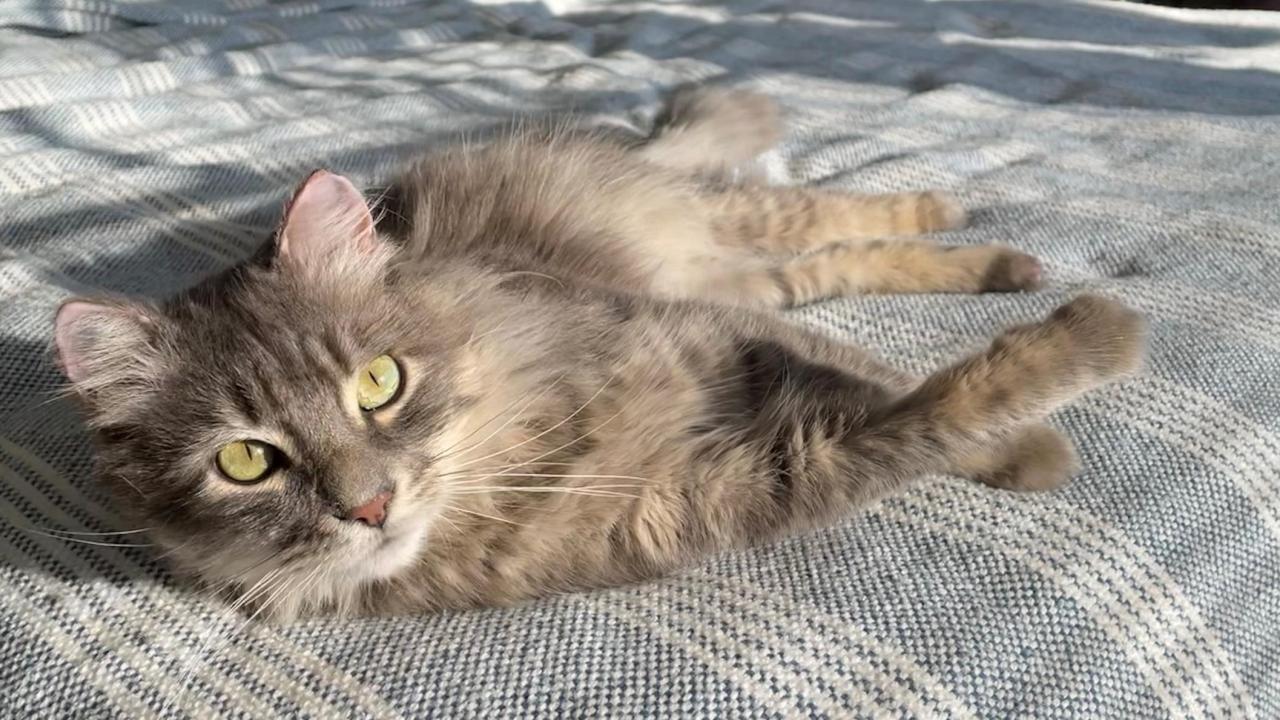
Following Six Months of Recovery at UC Davis, Severely Burned Cat Gets Adopted
“Case of the Month” – May 2021
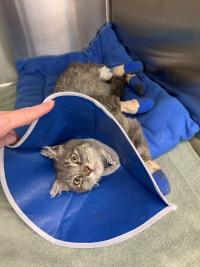
More than six months after being severely burned in California’s North Complex Fire, a cat treated at the UC Davis veterinary hospital has finally fully recovered and found his forever home. In the fall of 2020, thousands of animals were affected by the fire, and Jam, an approximately 2-year-old male cat, suffered some of the most horrific injuries of any of them.
Last fall, as the UC Davis Veterinary Emergency Response Team rescued, evaluated, triaged and/or treated approximately 1,200 animals in the fire zones, Jam was one of more than 60 animals brought to the UC Davis veterinary hospital for more advanced treatments, and the last to be fully discharged. When he was found in Berry Creek, a tiny community northeast of Oroville in the Sierra Nevada foothills, he had suffered third degree burns to his paws, many of his toes were fused together from the burns (all of which would later have to be amputated), and his whiskers were singed nearly completely off.
Jam arrived at UC Davis on September 21, 2020 and was first received by critical care specialists Drs. Kate Hopper and Steven Epstein and the Emergency Room (ER) team, who treated dozens of injured animals from the fire.
As they have with treatment of many cats from wildfires, Drs. Elizabeth Montgomery and Karen Vernau volunteered to take over Jam’s care following initial treatment in the ER. On top of their full-time duties with the Community Surgery and Neurology/Neurosurgery Services, respectively, they remained Jam’s primary veterinarians throughout his six months of care in the hospital’s new Feline Treatment and Housing Suite.
Drs. Montgomery and Vernau performed daily cleanings, treatments, and re-bandages on his burned paws. Included in Jam’s care team were several members of the small animal patient care team. These veterinary technicians went the extra mile, helping the veterinarians by having medications and supplies ready by 7 a.m. so Jam’s bandage changes could be completed in time for Drs. Montgomery and Vernau to make their regularly scheduled teaching and clinical duties. These daily bandage changes lasted for several months.
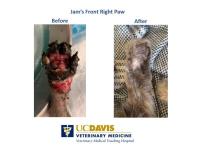
By October 9, Jam improved well enough to be cared for at home by Class of 2023 DVM student Megan Rivera, event coordinator of the UC Davis Orphan Kitten Project (OKP), a rescue group run by veterinary students and mentored by Dr. Vernau. Rivera would foster Jam for the next five months, with occasional help from fellow veterinary student and OKP member Vivia Liang.
Throughout fostering, Rivera and Liang administered medications as needed at home and facilitated Jam’s daily visits to the hospital, which were still required for cleanings and bandage changes. Rivera and Liang stayed on top of Jam’s care routine and joined Drs. Montgomery and Vernau in the treatment process, gaining valuable burn wound care experience.
“It was a wonderful opportunity to be Jam’s medical foster,” said Rivera. “His bandage treatments let me better understand the techniques involved in healing by secondary intention of burn wounds.”
Throughout Jam’s treatment process, members of the Soft Tissue Surgery Service were consulted regularly about the progress of his recovery. When a burn wound on his rear right leg still was not healed by the beginning of March, Dr. Ingrid Balsa opted to perform a skin graft procedure. Extra skin was removed from Jam’s left chest wall and sutured over the burn wound to promote healing. The procedure was completed without complications, and Jam recovered well following a few days of observation in the hospital.
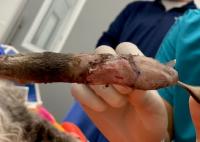
At his 3-week recheck appointment following the skin graft, Jam’s graft was almost completely healed, and his sutures were removed. Based on how good the graft appeared at that recheck, surgeons elected to not replace the bandage, and the end to Jam’s long road to recovery was in sight.
Throughout his burn treatments, Jam also battled diarrhea and ringworm, which were both treated successfully by Drs. Tarini Ullal and Stanley Marks in the Internal Medicine Service, as well as through consultations with the Dermatology Service.
“Jam’s case is a wonderful example of the possibilities of collaborative care at UC Davis,” said Dr. Jane Sykes, chief veterinary medical officer. “It is a true testament to the passion and dedication that our faculty and staff have to preserving the well-being of animals against all odds.”
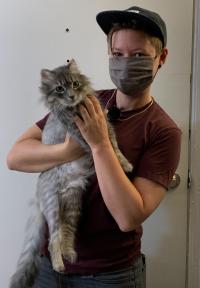
By the end of March, Jam was ready to be adopted, so OKP placed his profile online. Ash Ward, a UC Berkeley graduate living in Oakland, spotted his adoption notice and placed an inquiry to OKP. Ward has many connections to UC Davis – her girlfriend is a student in the law school, and she has been to the veterinary school before to visit friends who were former students. But there was one additional factor that made Ward feel that her discovering Jam was meant to be – Jam was initially named Ash by the hospital staff.
“When I saw that he had the same name as me, I felt it was a bit serendipitous,” Ward said.
She finalized his adoption on April 18 and changed his name to Jam. Ward reports that Jam is doing well in his new home.
“The first time I went to see Jam, he was still timid and was not moving around much,” said Ward. “But now he’s running around doing ‘zoomies’ all the time, and he likes to wrestle with my other cat Biscuit.”
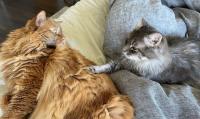
Biscuit and Jam are still figuring out their friendship, but life is certainly on the upswing for Jam.
“It’s been a long road for Jam and his medical and foster teams,” said Dr. Vernau. “This was a huge undertaking for everyone involved, including Jam, but worth it for this outcome. Dr. Montgomery and I are ecstatic that we have a healthy and happy cat ready to start a new life with his adopter.”
# # #
Jam’s care was covered by donations to the school’s Veterinary Catastrophic Need Fund, which provides veterinary medical treatments at the UC Davis veterinary hospital for animals that are injured in wildfires, natural disasters, or other accidents. As the current veterinary hospital transforms into the future Veterinary Medical Center over the next decade, donations from friends of the school, corporate partners, grateful clients, and community members will make up the majority of the funding needed. The school’s ability to treat more animals like Jam will be greatly enhanced in the VMC, as the school can increase its ability to be the go-to veterinary resource for California during times of crisis.
